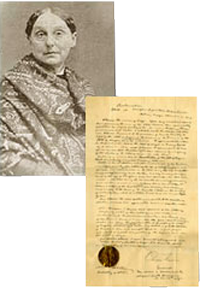 Abigail Scott Duniway struggled for years before finally earning the right to vote in Oregon in 1912.(OSA, Secretary of State Records)
Abigail Scott Duniway struggled for years before finally earning the right to vote in Oregon in 1912.(OSA, Secretary of State Records) Handwritten women's suffrage proclamation imageTranscript of proclamation
Handwritten women's suffrage proclamation imageTranscript of proclamation
A Woman's Role
Significant differences existed between the lives of typical Oregon women living in the city and those in rural areas. Yet, in general, they lived in a male dominated society. By today's standards, Oregon women had few legal rights. But while women exercised limited legal and political power, they held significant moral power in traditional society.
Developing out of the rise of the middle class a century earlier, the "cult of domesticity" saw women as the keepers of the home and the family's moral well being, This societal ideal saw the outside world where the husband worked as corrupt and full of temptations. In contrast, the wife oversaw a domestic world focused on piety, purity, and submissiveness. She was expected to maintain a cheerful and peaceful home that would keep her husband away from the evils of the larger world and provide her children with a sound moral upbringing. Homes and families across Oregon, particularly middle-class Portland homes, adhered to this ideal well into the 20th century.
But in the half century before World War I, pioneers such as Abigail Scott Duniway fought tirelessly for an expansion of women's rights. Women's suffrage, or the right to vote, formed the centerpiece of the effort, which finally passed a state vote in 1912. The new power at the ballot box began to empower women outside the home in other ways as well. And as the war effort began, many women moved into jobs that had been held exclusively by men. This created temporary opportunities during the war but, for women tired of traditional constraints, raised expectations even more about their evolving role in society.
Minorities Need Not Apply
Oregon's long history of racial and ethnic discrimination got its start with the treatment of Native Americans in the mid-1800s. Essentially, those who did not die as a result of diseases brought by the white settlers, were moved to the side so as not to impede the progress Manifest Destiny demanded. As a result, the great majority of Oregon's Native Americans were forced to live on reservations.
Chinese immigrants moved into the mining areas of southern Oregon in the 1850s and later to areas of northeast Oregon. They gained a reputation for hard work, often reworking mining claims that had been abandoned by white miners. Chinese workers also toiled long hours as cooks, housecleaners, and launderers in the busy mining towns.
But resentment grew in the white dominated communities, where many claimed the immigrants were taking jobs that belonged to white settlers. Because of their distinct language and social customs, the Chinese workers largely kept within their own tightly knit communities, often sending their earnings to their families in China. This only spurred more resentment in the white community. The discrimination made its way into the 1857 Oregon Constitution, which barred future Chinese immigrants from owning land or mining claims or from voting. Adding insult to injury, the territorial legislature passed a measure that levied a tax of $2 a month on each Chinese miner.
African Americans also were openly unwanted by the overwhelmingly white population of settlers to Oregon. Out of over 52,000 state residents in 1860, a mere 124 were blacks or mulattoes. Over the decades, those few African Americans and other minorities who managed to make a living in Oregon routinely lived as second class citizens, both in the eyes of the law and the minds of most Oregonians. Minorities commonly were refused housing as well as access to many businesses such as hotels and cafes.
In time, the dominant white society saw only certain jobs as acceptable for African Americans. These generally included menial labor such as cleaning stables and service work such as shining shoes. In spite of the hurdles, by the early 1900s small numbers of blacks were making inroads as doctors, lawyers, and businessmen. Others, particularly in Portland, opened restaurants, barber shops, and stores serving a growing, and culturally rich, inner city African American community.
 Phrenology, the popular 1800s study of the shape of the skull, was thought to offer insight into the relative intelligence and character of individuals as well as racial and ethnic groups. (Image, Library of Congress)
Phrenology, the popular 1800s study of the shape of the skull, was thought to offer insight into the relative intelligence and character of individuals as well as racial and ethnic groups. (Image, Library of Congress)
A Suspect Theory
The largely white, Anglo-Saxon social power base of the community also kept ethnic minorities in a second-class status. Social Darwinism, the application of "survival of the fittest" logic to society, held sway in the decades before World War I. While various branches of related "pseudoscience" developed, many people, including noted scholars, believed in a sort of pyramid of natural selection that placed those of northern European descent at the top. Lower levels were occupied by eastern and southern Europeans, Jews, Gypsies, Latinos, and other "less advanced" ethnic minorities. Of course, racial minorities such as Asian Americans and African Americans were at the bottom of the pyramid.
According to this theory, those at the top of the pyramid had the skills and the resulting duty to provide leadership and make decisions. Those at the lower levels were expected to work more with their backs, less with their minds and remember their "place" in the community. As immigrants flowed into the state in the late 1800s and early 1900s, Social Darwinism conveniently provided society with the means to justify and maintain the political, economic, and social status quo.